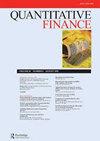Deep reinforcement learning for option pricing and hedging under dynamic expectile risk measures
IF 1.4
4区 经济学
Q3 BUSINESS, FINANCE
引用次数: 0
Abstract
Recently equal risk pricing, a framework for fair derivative pricing, was extended to consider dynamic risk measures. However, all current implementations either employ a static risk measure that violates time consistency, or are based on traditional dynamic programing solution schemes that are impracticable in problems with a large number of underlying assets (due to the curse of dimensionality) or with incomplete asset dynamics information. In this paper, we extend for the first time a famous off-policy deterministic actor-critic deep reinforcement learning (ACRL) algorithm to the problem of solving a risk averse Markov decision process that models risk using a time consistent recursive expectile risk measure. This new ACRL algorithm allows us to identify high quality time consistent hedging policies (and equal risk prices) for options, such as basket options, that cannot be handled using traditional methods, or in context where only historical trajectories of the underlying assets are available. Our numerical experiments, which involve both a simple vanilla option and a more exotic basket option, confirm that the new ACRL algorithm can produce (1) in simple environments, nearly optimal hedging policies, and highly accurate prices, simultaneously for a range of maturities (2) in complex environments, good quality policies and prices using reasonable amount of computing resources; and (3) overall, hedging strategies that actually outperform the strategies produced using static risk measures when the risk is evaluated at later points of time.动态预期风险下期权定价与套期保值的深度强化学习
最近,公允衍生品定价框架等风险定价被扩展到考虑动态风险度量。然而,所有当前的实现要么采用违反时间一致性的静态风险度量,要么基于传统的动态规划解决方案,这些方案在具有大量底层资产(由于维度的诅咒)或资产动态信息不完整的问题中是不切实际的。在本文中,我们首次将一个著名的off-policy deterministic actor-critic深度强化学习(ACRL)算法扩展到解决一个风险厌恶的马尔可夫决策过程的问题,该决策过程使用时间一致的递归预期风险度量来建模风险。这种新的ACRL算法使我们能够为期权(如一揽子期权)确定高质量的时间一致的对冲政策(和相等的风险价格),这些期权无法使用传统方法处理,或者只能在基础资产的历史轨迹可用的情况下处理。我们的数值实验,包括一个简单的香草期权和一个更奇特的篮子期权,证实了新的ACRL算法可以产生(1)在简单的环境中,几乎最优的对冲政策和高度准确的价格,同时对于一系列期限(2)在复杂的环境中,良好的质量政策和价格使用合理的计算资源;(3)总体而言,当风险在稍后的时间点进行评估时,对冲策略实际上优于使用静态风险度量产生的策略。
本文章由计算机程序翻译,如有差异,请以英文原文为准。
求助全文
约1分钟内获得全文
求助全文
来源期刊

Quantitative Finance
社会科学-数学跨学科应用
CiteScore
3.20
自引率
7.70%
发文量
102
审稿时长
4-8 weeks
期刊介绍:
The frontiers of finance are shifting rapidly, driven in part by the increasing use of quantitative methods in the field. Quantitative Finance welcomes original research articles that reflect the dynamism of this area. The journal provides an interdisciplinary forum for presenting both theoretical and empirical approaches and offers rapid publication of original new work with high standards of quality. The readership is broad, embracing researchers and practitioners across a range of specialisms and within a variety of organizations. All articles should aim to be of interest to this broad readership.
 求助内容:
求助内容: 应助结果提醒方式:
应助结果提醒方式:


